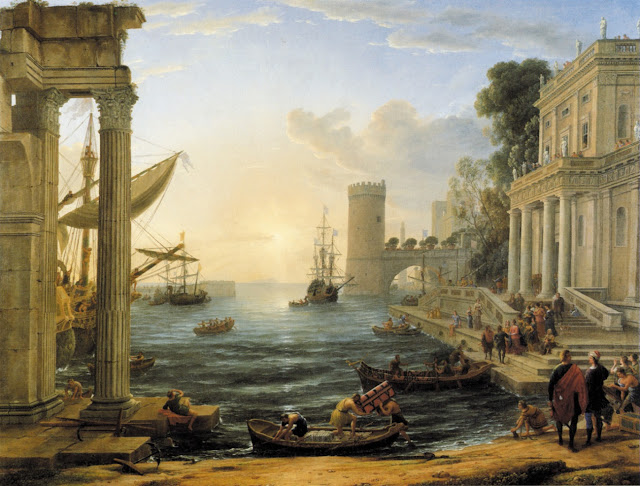 |
| Claude Lorrain Embarkation of the Queen of Sheba 1648 oil on canvas National Gallery, London |
Theatralization of Painting
A canvas by Claude Lorrain is often built of several framing structures set one behind and inside another. This is the scenic space of the Italian theater – a silhouetted series of receding apertures accentuating perspective at multiple points and on multiple planes: here, for example, the columns at left between which is glimpsed the mast of a ship in process of arriving or departing.
Indeterminacy of Time or Location
Often, it is difficult to say if a scene transpires in the morning or the evening, if the sun is rising or setting. The painter's intention is to capture a moment of transition, the shift from one state to another. Thus, "embarkation" – the departure for somewhere else – and in the case of the Queen of Sheba the distance is great, since her realm corresponded in some sense with absolute distance for the 17th-century viewer. It was located outside the farthest borders of the Roman Empire. In the mind of a painter who lived in Rome, this was a sort of America, a world beyond the frontier, a land of discovery and mystery.
But we are here concerned with the departure of the queen from her distant country on a voyage to the kingdom of Solomon. Here is the biblical account, from the first Book of Kings: "And when the Queen of Sheba heard of the fame of Solomon concerning the name of the Lord, she came to prove him with hard questions. And she came to Jerusalem with a very great train, with camels that bare spices, and very much gold, and precious stones. And when she was come to Solomon, she communed with him of all that was in her heart. And Solomon told her all her questions: there was not anything hid from the king which he told her not." According to Christian tradition the time of Solomon dated much earlier than the Roman Empire. Yet to paint this earlier epoch Claude employs the architectural vocabulary of the Romans. It is as if the country of Sheba represents the Roman future, like a prefiguration of the New Jerusalem.
The Theater of History
This canvas dates from 1648. It falls between the first phase of Corneille's theater and that of Racine. The period was marked by unification of territories and language under the rule of Richelieu, who aimed at making Paris dominant over the rest of France. Important social changes accelerated, with two large classes pulled into greater and greater competition. The nobility was losing ground; real power was evaporating, even as empty privileges expanded. The former influence of the nobles gradually faded, like a setting sun, while the bourgeoisie irresistibly ascended. We read in Proust how such real-world diminishments among the Guermantes crystalized as increased snobbery: they no longer possessed significant authority, so clung the more fiercely to their remaining prerogatives of inherited wealth and the glamor attached to their ancient name.
The Queen's Foot
In the middle ground at right, the queen is about to set foot in the small boat that will carry her out to the ship. Descending the quay, she raises the edge of her robe. The spectator remains suspended at this decisive moment. The revealed foot no doubt represents an image of beauty, like that of Cinderella, but this beauty is perhaps strange, exotic, troubling. The Koran is the first source that raises questions about this foot, in the Surah called The Ants. Solomon, who has heard reports of the queen, sends her a letter, to which she responds by sending him a magnificent throne, and then coming to meet him herself. It was said to her, "Enter the palace!" But when she saw it, she thought it was a pool, and she tucked up her clothes, uncovering her legs. Solomon said "Verily, it is a palace paved smooth with a slab of glass."
In reference to this enigmatic passage all sorts of traditions grew up, including one that attributed to the Queen of Sheba a goat's foot that she wanted no one to see. Claude Lorrain most certainly had not read the Koran, but Rome was a crossroads of merchants from all over the Mediterranean who might well have conveyed some of the legends that turned the Queen of Sheba into a still more mysterious personnage, suggesting for her an affinity with fauns or the devil.
In his Voyage en Orient, Gérard de Nerval ridicules King Solomon. Balkis, Queen of Sheba, appears before him as the mocking representative of happiness.
– translated and adapted from Le Musée imaginaire de Michel Butor: 105 œuvres décisives de la peinture occidentale (Paris: Flammarion, 2019)